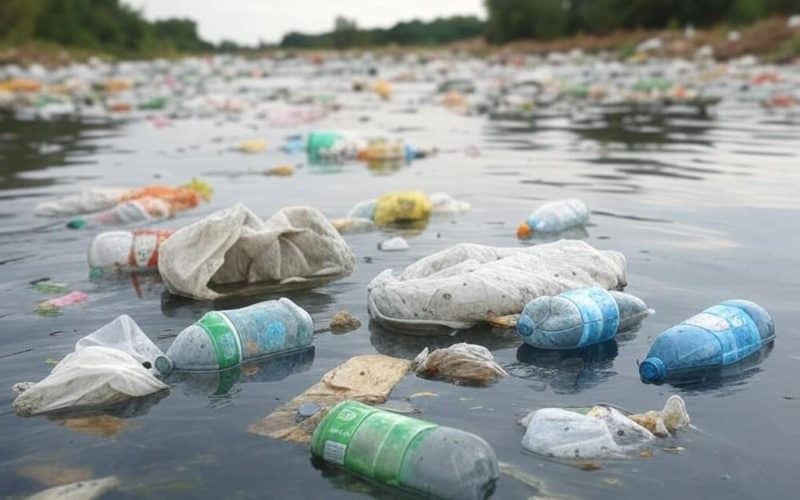
Rivers are vital to ecosystems and human societies, providing water, transportation, and livelihoods. However, the pervasive issue of waste disposal into these waterways (aka waterway pollution) has escalated into a global environmental crisis. And it’s not just industrial waste but also household garbage that ends up in the waterways as the video below clearly shows.
Annually, an estimated 19 to 23 million tonnes of plastic waste enter aquatic ecosystems, including rivers, lakes, and seas. This equates to over 2,000 garbage trucks dumping plastic into these water bodies every day.
Rivers serve as major conduits for this pollution, transporting significant amounts of waste to the oceans. Research indicates that approximately 1.4 million tonnes of plastic are carried from rivers to the ocean each year.
Место обитания 🐷 .
— Ivo 2 🇱🇻♥️🇺🇦 (@Ivo21840813) January 9, 2025
Это Маланг , Восточная Ява , Индонезия . pic.twitter.com/40BKBH33Kh
Environmental and Health Impacts of Waterway Pollution
Disposing of waste in rivers poses severe environmental and health challenges, particularly in developing countries.
Key issues include:
- Water Pollution: Dumping garbage into rivers introduces harmful substances, including plastics, chemicals, and organic waste, leading to contamination of water sources. This pollution disrupts aquatic ecosystems and renders water unsafe for human consumption and agricultural use.
- Health Hazards: Contaminated river water becomes a breeding ground for waterborne diseases such as cholera, dysentery, and typhoid fever. Communities relying on these waters for drinking, bathing, or irrigation face increased health risks, including gastrointestinal illnesses and skin infections.
- Ecosystem Disruption: Garbage accumulation depletes oxygen levels in water, harming fish and other aquatic life. This ecological imbalance can lead to the decline of biodiversity and the collapse of local fisheries, affecting food security and livelihoods.
- Economic Impact: Polluted rivers can diminish tourism, reduce property values, and increase healthcare costs due to pollution-related illnesses. Additionally, the expense of cleaning polluted waterways strains limited public resources.
- Accumulation of Non-Biodegradable Waste: Materials like plastics persist in the environment, breaking down into microplastics that infiltrate the food chain, posing long-term health risks to both wildlife and humans.
Contributing Factors
Several factors exacerbate river pollution:
- Inadequate Waste Management: Lack of proper waste collection and disposal systems leads to direct dumping into rivers.
- Industrial Discharges: Factories located near rivers may release untreated or inadequately treated waste into waterways.
- Urban Runoff: Rainfall can wash litter from streets into storm drains that lead directly to rivers.
Global Hotspots
Certain rivers are notorious for high levels of pollution due to waste and garbage:
- Yangtze River, China: Responsible for transporting approximately 1.47 million tonnes of plastic waste to the ocean annually.
- Indus River, Pakistan: Contributes around 164,000 tonnes of plastic waste to the ocean each year.
- Yellow River, China: Transports over 124,000 tonnes of plastic waste into oceans per year.
Addressing the Challenge of Waterway Pollution
Mitigating river pollution from garbage requires:
Implementing Physical Debris Removal Systems
Deploying devices such as litter traps, mesh drains, booms, and automated collection systems can capture floating debris before it reaches larger water bodies. For instance, River Cleanup’s “Clean River Model” emphasizes understanding river parameters and ecosystem services to design effective action plans.
Adopting Green Infrastructure
Introducing green infrastructure solutions like permeable pavements, rain gardens, and green roofs can reduce stormwater runoff, which often carries waste into rivers. These measures help manage stormwater at its source, preventing debris from entering waterways.
Enhancing Waste Management Systems
Developing efficient waste collection and recycling programs is crucial to prevent garbage from reaching rivers. This includes providing adequate waste disposal facilities and promoting recycling initiatives within communities.
Promoting Community Engagement and Education
Educating local communities about the environmental impact of river pollution and involving them in cleanup activities can lead to significant improvements. Organizations like River Cleanup focus on raising awareness and mobilizing volunteers to participate in river cleaning efforts.
Enforcing Environmental Regulations
Implementing and enforcing policies that prohibit dumping waste into rivers is essential. Regular monitoring and imposing penalties for violations can deter illegal disposal practices.
Utilizing Innovative Technologies
Employing advanced technologies such as floating treatment wetlands, which use plants to absorb pollutants, and automated robots designed to collect surface debris, can enhance the efficiency of river cleanup efforts.
Restoring Natural Habitats
Rehabilitating wetlands and riparian buffers can naturally filter pollutants and provide a habitat for wildlife. Healthy ecosystems improve water quality and reduce the impact of pollution.
Implementing these solutions requires collaboration among governments, non-governmental organizations, local communities, and the private sector to achieve sustainable outcomes in river pollution management.
Case Studies of Successful River Cleanup Initiatives
Several river cleanup initiatives around the globe have demonstrated the effectiveness of combined efforts.
For this article we’ll take a look at two successful cases:
- Cuyahoga River, USA: Once infamous for its pollution, the Cuyahoga River’s repeated fires from industrial waste in the mid-20th century galvanized public awareness and led to substantial legal and regulatory changes. The collaboration between local agencies and the community has proven vital in ensuring that restoration efforts align with the needs and desires of the population.
- Yodo River, Japan: The Yodo River in Japan has faced significant pollution challenges due to urbanization and industrial activities. In response, a collaborative effort involving government agencies, local communities, and environmental organizations initiated extensive cleanup initiatives. These efforts included sewage system upgrades and riverbank restoration, leading to the revitalization of the Yodo River. Today, it serves as a recreational hub for residents and visitors, boasting clean water and thriving ecosystems. A nationwide analysis of plastic litter recovery in Japanese rivers highlighted that the Yodo River system had an average plastic waste collection volume of 91.6 tons per year. This accounted for a significant portion of Japan’s total plastic collection volume, underscoring the importance of targeted cleanup efforts in this river system.
Challenge Are Great, The Rewards Of Success Are Immeasurable
The battle against river pollution is one of the most urgent environmental challenges of our time. Rivers, the lifeblood of countless ecosystems and communities, have become repositories for garbage and waste due to decades of negligence and inadequate waste management. Yet, amidst this crisis lies an opportunity a chance to act decisively and reverse the tide of destruction.
Rivers are more than just watercourses; they are ecosystems teeming with life, crucial sources of freshwater, and irreplaceable cultural and economic resources. Every piece of garbage thrown into a river disrupts this delicate balance, threatening biodiversity, compromising water quality, and endangering the health of millions who rely on these water bodies. The problem is not isolated to one country or region; it is a global challenge that requires collective effort and innovative solutions.
However, as daunting as the issue seems, it is solvable. Numerous successful river restoration projects around the world prove that change is possible. Just look at the revitalization of the Cuyahoga River in the United States, once infamous for catching fire, to the Yodo River in Japan, which has transformed from a polluted waterway to a thriving ecosystem.
The solutions are within reach. Implementing efficient waste management systems, enforcing strict environmental regulations, and promoting public education on responsible waste disposal are critical first steps. Adopting innovative technologies like floating treatment wetlands and robotic debris collectors can hugely enhance cleanup efforts. Simultaneously, investing in green infrastructure and restoring natural habitats along riverbanks can prevent further pollution and nurture biodiversity.
Equally important is community engagement. Rivers often serve as the heart of local communities, and empowering these communities to take an active role in protecting their water bodies is a game-changer. Public awareness campaigns, community-led cleanup drives, and inclusive policymaking can foster a sense of ownership and responsibility among citizens.
As individuals, our choices matter. Each small action, when multiplied across millions of people, creates an unstoppable wave of change.
